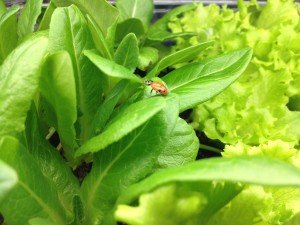I needed to travel to New Orleans last week on business and snapped a couple of pics of my indoor and outdoor gardens before I headed to the airport. I told myself that I took the pics in case I had time to update this blog while I traveled, but the truth is that I really enjoy seeing my little gardens every day whether I am home or not.Indoor garden
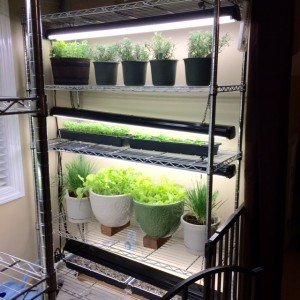
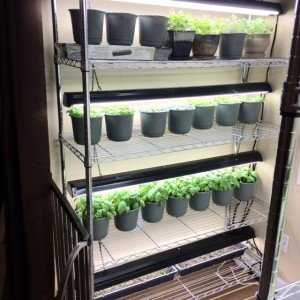 Outdoor garden
Outdoor garden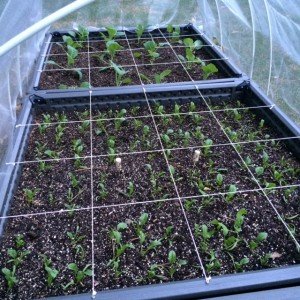 And now that I am home and it is almost the weekend...expect an update!
And now that I am home and it is almost the weekend...expect an update!
Touch of Lace
There is a period of heightened vigilance after bringing in container trees to overwinter in a sunny window. They have been out in nature since spring and nature will come in with them.This year I found a couple of small spiders on my trees who were left to carry on and a cabbage worm chomping on my fig's leaves who was not. To my surprise, almost a month after bringing them in I noticed delicate, white structures on the underside of a Meyer Lemon leaf. They were too perfect, too orderly, too fragile to not call them beautiful.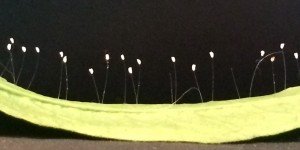 Some quick research gave them a name - they are the eggs of the Lacewing, a beneficial insect that has a fondness for eating aphids. I have known the name for many years but could not have said if they were pests or beneficial (somewhat arbitrary terms anyway) or what they looked like.You meet the most interesting bugs when you garden...
Some quick research gave them a name - they are the eggs of the Lacewing, a beneficial insect that has a fondness for eating aphids. I have known the name for many years but could not have said if they were pests or beneficial (somewhat arbitrary terms anyway) or what they looked like.You meet the most interesting bugs when you garden...
The Great Indoors
The leaves are turning, the mornings are a bit crisper and all of the big box stores have hauled out their Christmas items....that can mean only one thing - its time for NHG to head indoors!As I sifted through listings looking for my Raleigh area home, the garden potential of the backyard and the indoor gardening space were priorities. I use intensive, raised bed gardening outdoors so I can grow a lot in a little space outdoors and the same is true indoors. I have set up in my indoor garden in a dormer nook in my bonus room that measures 48" deep by 74" wide. I have two 4' x 18" chrome finished utility shelves equipped with shop light fixtures to grow my herbs and tender greens. My indoor garden is great in summer months to grow lettuce and spinach that cannot tolerate the summer heat but it really comes into its own during the winter when it serves as my main source of fresh herbs and greens. What I have growing so far are:
My indoor garden is great in summer months to grow lettuce and spinach that cannot tolerate the summer heat but it really comes into its own during the winter when it serves as my main source of fresh herbs and greens. What I have growing so far are:
- 13 Genovese Basils
- 3 Cilantros
- 1 Oregano
- 1 Mint (on consignment for my neighbor who wants it for a Kentucky Derby party next year)
- 4 Rosemarys
- 2 Garlic Chives
- 2 Leaf Lettuce varieties
- Basil and Cilantro microgreens
I will light up additional shelves as the season wears on to add more lettuces and more microgreens (I love arugula and mustard for salad and sandwiches) but this is the official start of the off-season garden.
'Shrooms Abound
I have a couple of mushroom projects going on.Shiitake - I am on my second round of growing Shiitakes that I ordered from 100th Monkey Mushroom Farm. I had been wanting to try growing them for a couple of reasons. They grow well indoors, I am using Shiitake all the time in my homemade ramen noodle soup and what a conversation piece!I ended up ordering from this company because I loved the tutorial videos with Jim on their YouTube channel. The Shiitake video gives tips on getting 3 full growing rounds out of the block which costs $33 (before shipping) for an estimated total harvest of 2-3 lbs.My first round with the Shiitake blocks (I ordered and grew two of them) resulted in 10.2 oz fairly split between the two.
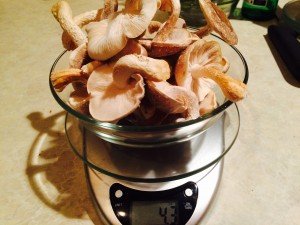 The second round is a bit more asymmetrical with Block B doing well and Block A (which slightly outperformed Block B in the first round) doing nothing so far.
The second round is a bit more asymmetrical with Block B doing well and Block A (which slightly outperformed Block B in the first round) doing nothing so far.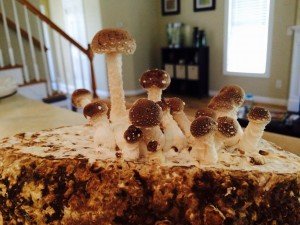 Time will tell and I am looking forward to the third round when I will layer the block medium along with straw into a plastic planter with holes drilled in the sides for the final opportunity to grow and harvest.Before I started this project I made note of what I was purchasing Shiitakes for ($1.10 oz) to compare my $33 investment to the retail costs. I have a ways to go to make this project actually be a money saver, but it has been fun and I know the mushrooms I am enjoying are fresh, well grown and harvested within 5 days of use making the monetary aspect more of a fun side project.Next on my list to try are the Elm Oyster Mushrooms from this same company. As soon as I figure out which recipes to use them in, I will be ordering a box kit.Morels - my other mushroom project is one that mushroom enthusiasts have long thought impossible - cultivating morels! These elusive and highly prized forage mushrooms have proven impossible to cultivate for decades, but a couple of companies believe they have cracked the code and are now selling morel spawn along with cultivating instructions.This is more of a long term project since the instructions specify that real production is not expected until the second spring after bed preparations. I purchased my kits from Gourmet Mushrooms and I started two 4 square foot beds about 20 feet apart to try this for myself. I grew up hunting morels in spring and have found them at the Farmer's Market selling for upwards of $20 lb. in the past few years. They are a wonderful, seasonal treat and the idea of harvesting them from my back yard for years to come was well worth the $33 per kit. Due to the time involved and the weekly compost feeding required, this project is not for everyone but if you are dedicated to the idea of having a ready supply of morels in an easy to harvest location, it might be worth your while.
Time will tell and I am looking forward to the third round when I will layer the block medium along with straw into a plastic planter with holes drilled in the sides for the final opportunity to grow and harvest.Before I started this project I made note of what I was purchasing Shiitakes for ($1.10 oz) to compare my $33 investment to the retail costs. I have a ways to go to make this project actually be a money saver, but it has been fun and I know the mushrooms I am enjoying are fresh, well grown and harvested within 5 days of use making the monetary aspect more of a fun side project.Next on my list to try are the Elm Oyster Mushrooms from this same company. As soon as I figure out which recipes to use them in, I will be ordering a box kit.Morels - my other mushroom project is one that mushroom enthusiasts have long thought impossible - cultivating morels! These elusive and highly prized forage mushrooms have proven impossible to cultivate for decades, but a couple of companies believe they have cracked the code and are now selling morel spawn along with cultivating instructions.This is more of a long term project since the instructions specify that real production is not expected until the second spring after bed preparations. I purchased my kits from Gourmet Mushrooms and I started two 4 square foot beds about 20 feet apart to try this for myself. I grew up hunting morels in spring and have found them at the Farmer's Market selling for upwards of $20 lb. in the past few years. They are a wonderful, seasonal treat and the idea of harvesting them from my back yard for years to come was well worth the $33 per kit. Due to the time involved and the weekly compost feeding required, this project is not for everyone but if you are dedicated to the idea of having a ready supply of morels in an easy to harvest location, it might be worth your while.
Bloomin' Blueberries
During a very busy, task oriented day of seeding another 5 basil pots indoors, preparing the outdoor garden beds for hoop row covers to keep falling pine needles and cones out of the beds and starting another 16 dwarf collards, something caught my eye. The Premier Blueberries I migrated from containers to their permanent homes in the ground behind my deck back in July when I bought my house are blooming! These are my first blueberry bushes and my first blooms. Although I am concerned that they should be focusing on root growth and stability before the impending winter rather than flaunting their fecundity in the wrong season, I was so absolutely taken with the perfectly beautiful little bell blossoms that I stopped everything to snap a picture and revel in their elegance.
From 6a to 7b
Where Is NearlyHomeGrown?In 2012 I purchased 10 raised bed kits, filled them with the mix recommended by Mel Bartholomew (1/3 peat moss, 1/3 vermiculite, 1/3 compost) and had an intensive planting plan which resulted in an abundant harvest. I doubled the size of my indoor garden, started growing microgreens (in addition to, not instead of their macro counterparts) and started the whole process over for 2013 with lessons learned and plans for an even bigger garden.In May of 2013 a job opportunity arose that moved me from Wichita, Kansas (Hardiness Zone 6a) to Raleigh, North Carolina (Hardiness Zone 7b). Because I had purchased a durable raised bed product and made my own soil for my garden, I brought my garden with me. I spent a year renting a town home with no backyard but with a nice patio that I quickly filled with container trees and potted herbs while 2,000 lbs. of homemade soil in 40 gallon Rubbermaid containers sat waiting in my garage.In July of this year I purchased a home. Moving in meant unpacking boxes but also setting up my outdoor and indoor gardens and adding some fig trees and blueberry bushes to the productive capacity of my .2 acre lot and starting plans for even more variety in my plantings.That is a rough overview of what I have been up to since my last post. I have some interesting projects growing...
How Does My Garden Grow - Part 2
In mid December the indoor garden was really taking shape. The lettuce was doing great and providing a couple of salads a week, the spinach was coming along and the 3 basil plants I purchased from Wild Family Farm over the summer were looking seriously picked over due to my insatiable appetite for fresh basil on almost every meal.And then everything changed.On a shopping trip to Green Acres I spied some potted basil plants from a local greenhouse. I picked two of the most likely plants and congratulated ourselves on giving my basils at home a well earned rest and recoup. I took the new basils home and introduced them to my garden not knowing they were carrying aphids. Very healthy, fecund aphids.About a week later the aphid infestation became apparent. They engulfed the spinach, the swiss chard, the lettuce, the basils and even the kale! The only plants that were safe were the oregano, rosemary and chives.Prior to the introduction of the new basil plants, I essentially had a sterile environment. The previous owner had not had a single houseplant, and before my indoor garden, neither did I. After discovering the invasion, I quickly researched my opponent and learned that aphids are the bane of gardeners everywhere. I researched treatments methods that are considered organic and headed to the local Menard's. The first line of defense was Neem. I followed the instructions and made sure to get the undersides of leaves where aphids like to hang out. I used it for two weeks as directed and it reduced the aphid population, but then they rebounded again. I moved down the list and made a second attempt with a pyrethrin mix with the same results, an initial reduction in aphid population followed by a resurgence.Despite two disappointing experiences, I still wanted to stay organic if possible and decided it was time to try diatomaceous earth. Everything I read said this stuff would prove lethal not only to the aphid population, but also to any spiders, soft bodied flies or other insects that wondered too close. I coated all of the plants including the ones the aphids were avoiding. I coated the tops of the leaves, the undersides of the leaves, the top of the soil mix, I coated everything! Three weeks later all I had to show for this was dusty aphids.I had three choices at this point; go with some serious chemicals that would keep me out of the organic club, put all of my inside plants outside and let winter kill the aphids and the plants and try again in a month or so when I could be sure that all the aphids were gone or natural predators. I opted for the natural predator route with the caveat that if this didn't work, I was going to kill everything and start over. I ordered the ladybugs from a company with good reviews and 1,600 squirming ladybugs arrived a few days later.
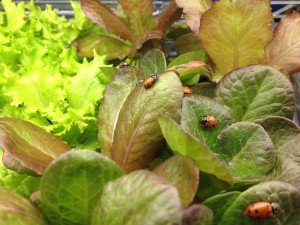 (ladybugs walking on the Merveille des Quatre Saisons lettuce)
(ladybugs walking on the Merveille des Quatre Saisons lettuce)
I released the ladybugs on all of the plants and waited. One day later the aphid population was scarce. Two days later I could not find an aphid anywhere! It has been two weeks now and the ladybug population is down to maybe 150, but still no aphids to be found. I have a suspicion that there are aphid eggs waiting to hatch, but also a hunch that the ladybugs may have pulled off the same trick due to the difficulty I had trying to take a photo that didn't include mating ladybugs! So I have high hopes that if there is a round of aphid hatchlings in my future, there will also a be a resurgence of the ladybug population around the same time.
How Does My Garden Grow
The lettuce and spinach I sowed on November 5th are doing very well. I waited until today to thin the plants so the non-winners in this evolutionary race could still make a small salad.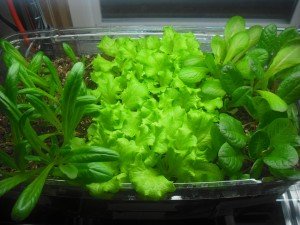 I have started a second batch that is beginning to sprout and hope that the staggering will keep me in fresh greens until spring when I can sow outdoors.I am also experimenting with a couple seeds of Five Color Silverbeet Swiss Chard. I am starting them in very small containers and will transplant into larger containers to grow indoors if they germinate well.My indoor growing space is at a premium right now and I am looking to expand what I can grow by doubling up on the growing shelves and lights with 2 deep on the wide shelves. At this rate I will probably need a second shelving unit before spring, but I am loving the results. This project is not a money saver right now. I have a long, long way to go before indoor gardening pays for itself, but I love being able to go downstairs and get some "just in time" basil, lettuce, rosemary, or oregano.
I have started a second batch that is beginning to sprout and hope that the staggering will keep me in fresh greens until spring when I can sow outdoors.I am also experimenting with a couple seeds of Five Color Silverbeet Swiss Chard. I am starting them in very small containers and will transplant into larger containers to grow indoors if they germinate well.My indoor growing space is at a premium right now and I am looking to expand what I can grow by doubling up on the growing shelves and lights with 2 deep on the wide shelves. At this rate I will probably need a second shelving unit before spring, but I am loving the results. This project is not a money saver right now. I have a long, long way to go before indoor gardening pays for itself, but I love being able to go downstairs and get some "just in time" basil, lettuce, rosemary, or oregano.
My Secret Garden
Maybe all new gardeners are as anxious as I am to get started. Maybe they all look at the approaching first frost date and say "I can outsmart nature". Maybe not. Either way, Patti Moreno made me do it.I have been watching a lot of the Patti Moreno, Garden Girl videos to learn about her version of Square Foot Gardening. In one episode she turns a sun room in her home into a nursery for her plant starts for spring with shelving and fluorescent fixtures and full spectrum grow lights. It was late October and I knew that I would want to get a head start on spring so I created a couple of grow shelves in my basement in front of a southern exposure window with the bulbs that Patti recommended and a timer. Besides, I still have those 3 basil plants that I purchased from the Farmer's Market this summer that I would like to keep going for as long as possible into the winter months as well as two rosemary varieties and an oregano.I waited one week.On November 5th I could wait no more (I already mentioned that Patti made me do it, right?). I knew that spinach and lettuce are cool weather plants and my basement stays just below 70 degrees. I had already received my order of Baker Creek Heirloom Seeds for my spring plantings and thought "why not see what happens?".I planted 3 varieties of heirloom lettuce and 2 varieties of heirloom spinach. The goal is to be able to cut off a couple of leaves of the still growing plants to enjoy some fresh greens between now and when the real plantings happen next growing season.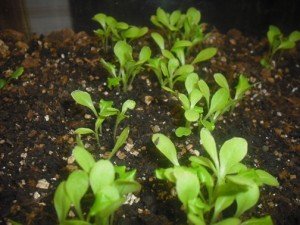 Less than 2 weeks later I have little lettuce and spinach starts in my secret garden. I hope that in another few weeks I will be able to begin harvesting leaves. I have another set of grow containers ready to go to get more started when I begin harvesting from this first run. I hope to continue this cycle until the Farmer's Markets reopen in May.
Less than 2 weeks later I have little lettuce and spinach starts in my secret garden. I hope that in another few weeks I will be able to begin harvesting leaves. I have another set of grow containers ready to go to get more started when I begin harvesting from this first run. I hope to continue this cycle until the Farmer's Markets reopen in May.
